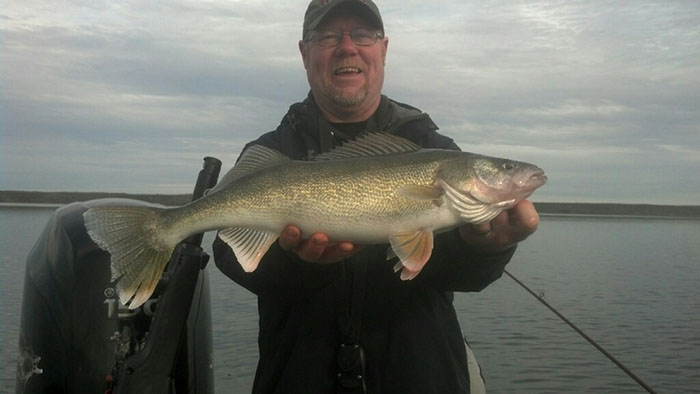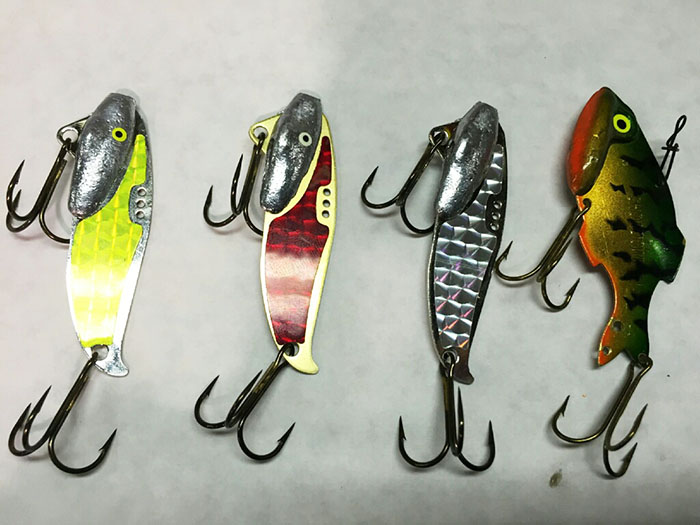Fish Blades for Early Potholes Walleye Leave a reply
Potholes Reservoir is currently locked up with more ice than the lakes seen in quite a few years. It’s been awful chilly in Eastern Washington since early December and that bout of cold weather continues to this day. So why are we talking about walleye then?
The second the ice comes off Washington’s Potholes Reservoir and the boat launches are finally useable again you’ll find a group of hardcore anglers hitting the reservoir in search of walleye. It could be another month or so before that happens but when it does it pays to be ready.
One of those anglers is longtime walleye guide Shelby Ross of PotholesFishing.com. Shelby lives on Potholes Reservoir and has guided for walleye and waterfowl on the lake for years.
When the ice burns off and you’re itchin’ to hit the lake here’s a few tips from the master himself that will put some early season walleye in your frying pan this spring.
Find the Bait, Find the Walleye
There’s no shortage of drop-off’s and humps in Potholes Reservoir and Shelby will hit as many as twenty of them in a day until he finds one loaded up with bait. He targets humps and ledges in 25 to 50 feet of water until he finds one that’s holding a bunch of bait. If the sonar screen looks promising he’ll toss a marker bouy out and keep cruising to see if there’s anything else in the vicinity.
Some of the areas that he’ll scope out first are the rock shelves around Goose Island, the north shoreline just west of Linn Coulee and the deep humps near the mouth of Crab Creek. These are all staging areas for the spawn and walleye are usually feeding in these areas in the months and weeks leading up to the spawn.
Once he’s got a good handle on exactly where the bait is he’ll stop the boat and start casting blade baits into the shallow water and work them out into deeper water. He say’s he’ll know instantly how good it is if they start catching perch right away. Find the perch and you’ve found the walleye.
The technique is somewhat simple to master but of course it does have it’s nuances. Shelby uses 1/2 ounce blades eighty percent of the time and has a few 3/8 and 3/4 ounce blades on board if he needs to switch up. If the walleye are just rattling the blades and they are missing a lot of hookups he’ll switch to a lighter 3/8 ounce blade first to give the lure a little slower fall. That usually produces a more aggressive strike and if that doesn’t work he’ll try the 3/4 ounce blade.
Position the boat on the deep end of the drop off and cast the blades up onto the shallow end of the ledge or hump. The lure should fall into about 25 to 30 feet of water. Once they hit the bottom start working them down the face of the ledge. He likes to work the jig up about a foot and then let it fall back to the bottom with the strikes always occurring on the drop. If you feel anything subtle or different about the action of the blade set the hook!
Make Your Own Blade Baits
Snagging up on the bottom is inevitable with this technique, so bring plenty of blades with you. Shelby spends some time in the winter months making up his own blade baits to cut the cost down a bit. He buys 3/8, 1/2, and 3/4 ounce nickel plated blades from Jann’s Netcraft and then adds the prism tape and hooks to finish them. His favorite prism tape colors are chartreuse, red, and silver and on any given day one can be hotter than the other.
He prefers to run Mustad split shank treble hooks on his blades because they greatly reduce the number of tangles. Blade baits with split rings are a tangle waiting to happen. Mustad split shank trebles are extremely sharp and they are easy to install on the blades.
Rig up for Success
Shelby likes a spinning rod in the eight foot range with a fast action. The sensitive tip allows him to feel the action of the blade and the backbone slams the hook home when a walleye picks up the blade. They can be surprisingly subtle and a sensitive rod tip definitely helps feel the bite.
He uses a Daiwa Excelor 2500 series reel spooled with 10 pound Power Pro braid. 10 pound Power Pro has the diameter of 2 pound test monofilament and it’s great for casting blade baits a country mile. The extremely small diameter line allows his guests to feel the action of the blade and contact with the bottom in water as deep as 50 to 60 feet.
He’ll attach a barrel swivel to the end of the braid and then he runs a bumper of six inches of 15 pound fluorocarbon between the swivel and the blade bait. The short section of flourocarbon is easy to cast, reduces tangles, and has some abrasion resistance against the blade bait and treble hooks.
Walleye don’t fair well when they’re caught out of deep water and it’s usually not possible to “high grade” fish when they’re caught in excess of twenty feet of water. If you land on the walleye in deep water keep your limit and head for the barn.
This has been one of the coldest winters in Eastern Washington in nearly a decade and Potholes has been locked up with ice since mid-December. When the ice finally comes off the lake though you can bet there will be walleye willing to jump all over a blade bait. Give some of Shelby’s tips a try and with any luck you’ll go home with some fresh walleye.
Rob Endsley
The Outdoor Line
710 ESPN Seattle



